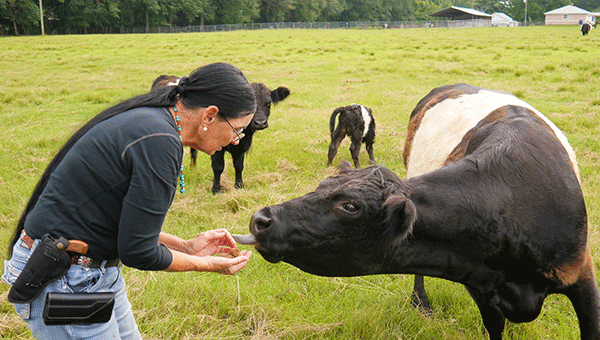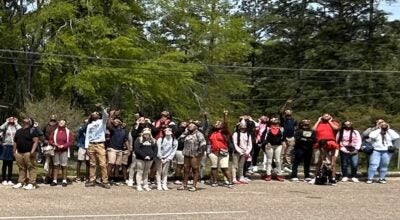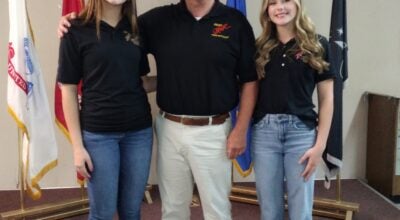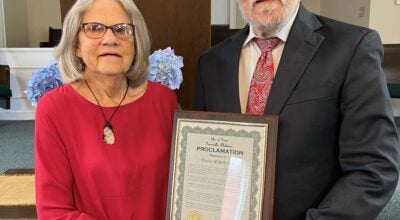Unique bovines thrive on Luverne farm: Floyd tries a different breed
Published 8:01 am Friday, July 28, 2017

Pat Floyd shares some pellets with one of her Belties. The breed is known for its generally docile and friendly nature. Journal Photo/Angie Long
Pat Floyd of Luverne never grows tired of the view from her back patio.
There are verdant pastures surrounded by woodlands, a pair of ponds that shimmer in the daytime sunshine and reflect the golden orb of the moon at night; ducks and geese gliding through the water and bird song in the air.
And those black cows—smallish for bovines, but muscular, some possessing dense curly-topped coats, all with bands of white completely encircling their middles. These docile, friendly cows, all with names like Mack and Mollie, are something special. They seem to know it, readily striking poses for visitors’ cameras.
Welcome to BAMA Belties Farm, Floyd’s peaceable kingdom located on Highway 331 North.
“These are my Galloway Belted cows . . . years ago, I was on a vacation in the mountains with my family. That’s when I saw some of this breed of cattle for the first time. I never forgot that,” Floyd, a retired college professor, explains. “Years later, I was raising Black Angus cattle and decided I wanted to go in a different direction. I remembered those wonderful cows with the belts and started searching for some registered Galloway Belties to buy.”
It was no easy matter finding the so-called “oreo” or “panda” cows.
“Most of the ones I found were in New York State, New England and Missouri. It was a long way to go for a cow,” Floyd laughs. “And most people only had one or two and weren’t willing to give up the ones they had.”
Eventually Floyd’s persistence paid off and she was able to start her own small herd. Today, she has 25 cows, four heifers, nine bulls and “lots of baby calves.” Belties from the blood line established at Floyd’s farm can now be found all over the Southeast and further afield.
The breed’s origins go back to the 16th century in Galloway on the west side of southern Scotland. From Scotland, the Belted Galloway was exported to England, and from there, across the Atlantic to Canada and finally, the United States.
Floyd’s Belties reflect the diversity within the breed. “There are both Narrow Belties and Wide Belties . . . you can see the difference in the width of their bands,” she points out during a tour by golf cart of her pasture land.
“My goal is to establish and perfect the wide belt here on my farm. In either case, wide or narrow, the requirements are that the belt completely circles the cow with no break.”
Floyd stops to hand out some pellets to the cattle, who quickly encircle her, ready for their treats.
“ You see that longish, coarse, curly top coat? Underneath it, there is a smooth, slick, soft undercoat. Some of this breed have only the smooth coat.”
Those double coats serve to protect the cattle from wind, rain and cold, allowing them to remain outside even during chilly, stormy weather.
And how do they manage south Alabama’s torrid summer heat? The same way some humans do—water.
“They love to get in the ponds—and the funniest thing is when the two dogs, Buddy and Palin, are out there paddling around with them,” Floyd laughs, adding, “They also love getting in the shade during the day . . . and then at night when it’s cooled off, they come out into the pasture and enjoy eating the grass.
The beef produced by these grass-fed cattle is premium quality, Floyd says.
“Beltie meat is the leanest beef available according to the USDA . . . and I only use antibiotics when a cow is sick and actually needs it; otherwise, I do not give them to any of my cows. Any new cows that are brought in, I keep quarantined in a back pen for a week or two to avoid introducing anything that could be harmful to my Belties.”
She points out one of her youngest additions, Mack, Mollie’s extremely handsome calf, born just over a month ago.
“I prefer the cows reach 20-22 months of age before having calves; conventional wisdom says closer to 14-18 months, but these are a smaller breed of cow and I want them to be fully strong and healthy. So they are kept in a separate pen until that time,” Floyd explains.
In a herd that already stands out in a crowd, one of her Belties really catches the eye.
“That is Peaches, my only red Beltie. I have wanted to get more, but that color is extremely rare and hard to find,” Floyd says.
And it seems this redhead lives up to a certain reputation.
“My other Belties are all so gentle and easygoing. Peaches—not so much. She does have a bit of a temper. Peaches is a very, very good mom, though. Much more protective than any of the other mothers.”
Floyd keeps a close eye on her expectant mothers and when the time draws near, it’s “birth watch” time.
“Earlier this year, I had my first breech birth to deal with. I was so afraid we’d lose that calf—but it went OK,” Floyd recalls.
There are the hazards with which most every farmer in the area has to deal—coyotes and wild hogs—and the occasional first-time heifer who needs to be taught to nurse her new baby. “Sometimes I’ve had to bottle feed the calf until Mama learns that calf is her responsibility.”
Floyd welcomes anyone interested in learning more about her unique bovines to visit the BAMA Belties Farm page on Facebook. Better yet, arrange a tour of the farm where you can meet Mack, Mollie, Caroline, Heather and the rest of the Belties, along with her geese, ducks, Buddy and Palin and Sawdust the cat.
“Everyone gets along out here. My little piece of heaven,” Floyd says with a smile.





